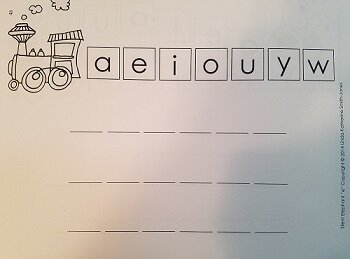So Precious! Phonemic Awareness Set His Imagination in Full Gear
Aren’t these just the most precious pictures of a proud, young boy using his imagination to create his own method to learn phonemic awareness!
Meet 4-year-old Xander!
Whenever Xander’s mom Wendy was teaching his sisters, 7-year-old Audrey and 9-year-old Zoya, Xander loved joining in the introductory, fun, whole body activities that went along with each lesson. (Previously, I sent you pictures of all three of these delightful children writing their words in pudding. Smiles fill my face as I reflect on those darling pictures.)
One day a wonderful idea suddenly popped into Wendy’s brain as she attentively watched the joy Xander was experiencing while participating in a Silent Elephant “e” lesson with his sisters.
“I should start teaching Xander Part 1, Phonemic Awareness! Ms. Linda says that Phonetic Reading with Silent Elephant “e” is for preschoolers to adults. We’ll start this afternoon!”
That very afternoon, Wendy taught Xander the first lesson in phonemic awareness using game board one with the colored squares. Xander loved the game as he began learning to listen to the individual sounds within words. Wendy was delighted with his quick progress!
Unexpectedly one day, Xander said, “I don’t want to use just the colored squares.”
Wendy explained patiently. “Xander, remember that Ms. Linda gave us the colored squares to use to play the games. We need to use the colored squares.”
“I want to use my cars!” exclaimed Xander.
“Show me how you would use your cars to play the game.” Wendy was puzzled, yet curious.
Xander eagerly ran to get his tub of cars. He got out gameboard one, put the colored squares on the caterpillar and then proudly placed a matching colored car below the colored square.
“Xander, you are brilliant! We will have even more fun learning with the colored squares and with your colored cars!” Wendy was bursting with pride at her son’s creativity!
Now Wendy is loving teaching all three of her children to read, write and spell with Silent Elephant “e”! They are sharing the joy of learning together.
Zoya and Audrey have just finished Part 6 and are looking forward to beginning Part 7. The girls are so proud of how much they know. They asked Mom to take pictures of them with sentences they wrote for the last lesson in Part 6. They were excited to show me their work.
Receiving success stories and pictures of parents and teachers teaching and children learning with Phonetic Reading with Silent Elephant “e” fills my heart with happiness!
I’d love to hear from you!
If you have further questions about phonemic awareness, feel free to contact us.






